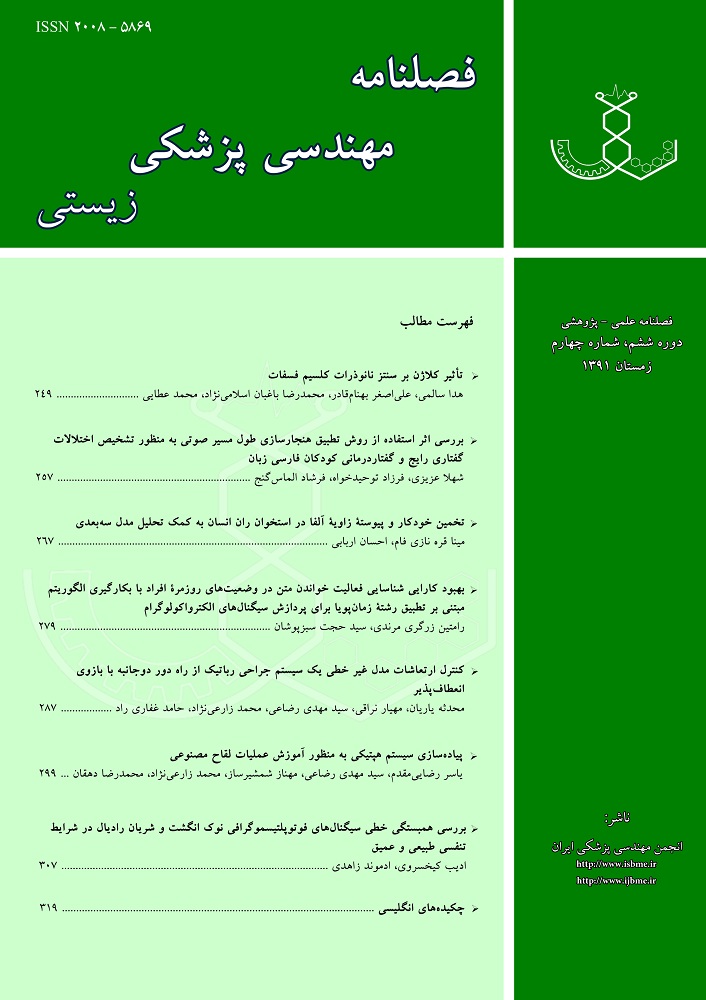نوع مقاله : مقاله کامل پژوهشی
نویسندگان
1 دانشجوی دکتری مهندسی پزشکی، دپارتمان مهندسی پزشکی، دانشگاه ویسکانسین- مدیسن
2 دانشیار، گروه مهندسی پزشکی، دانشکده برق، دانشگاه صنعتی شریف
چکیده
فوتوپلتیسموگرام (PPG) یکی از کمهزینهترین سیگنالها است که همواره مورد توجه محققان به منظور استخراج پارامترهای سیستم قلبی-عروقی مانند میزان اتساع شریانی در پی تحریک بوده است. در اکثر موارد PPGاز نوک انگشت ثبت میشود که تحت تأثیر سیستم خودتنظیم عروقی است، به طوری که موجب میشود نتایج حاصل با نتایج روشهای استاندارد مانند سونوگرافی همبستگی زیادی نداشته باشد. با توجه به اینکه شریانهای هدایتی فاقد سیستم خود تنظیمی هستند، در این تحقیق میزان همبستگی خطی PPGشریان رادیال بانوک انگشت بررسی شد. برای این منظور، با کمک آرایهای از فوتودیودها و یک LEDبا طول موج 960 نانومتر، یک پروب ثبتPPGاز شریان رادیال در مچ دست طراحی و ساخته شد. این طراحی بر پایه شبیهسازی برخورد نور و بافت به روش مونتکارلو انجام شد. سپس PPGمچی از شریان رادیال و PPGانگشتی از انگشت اشاره در شرایط تنفس طبیعی و تنفس عمیق ثبت شدند. در آزمایش اول (تنفس طبیعی) سیگنالها از 9 نفر اخذ شدند، که ضریب همبستگی بین PPGمچی و انگشتی برای سیگنال خام (AC+DC) برابر ٪1/12 ± ٪5/62، قسمت ACبرابر ٪9/6 ± ٪2/91، و قسمت DCبرابر ٪4/13± ٪61 به دست آمد. در آزمایش دوم (تنفس عمیق)، سیگنالها از 6 نفر ثبت شدند که ضریب همبستگی برای سیگنال خام ٪9/5 ± ٪7/89 ، قسمت ACبرابر ٪3/3 ± ٪7/93، و قسمت DCبرابر ٪9/5 ± ٪9/89 به دست آمد. این نتایج نشان میدهد که در شرایط تنفس طبیعی، فقط قسمتهای ACسیگنالها همبستگی خطی زیادی دارند؛ اما هنگامی که تنفس عمیق غالب میشود، هر دو قسمت ACو DCهمبستگی زیادی پیدا میکنند.
کلیدواژهها
موضوعات
عنوان مقاله [English]
Linear correlation of the fingertip and radial artery photoplethysmograms during normal and deep breath
نویسندگان [English]
- Adib Keikhosravi 1
- Edmond Zahedi 2
1 PhD student, Department of Biomedical Engineering, University of Wisconsin-Madison
2 Associate Professor, Electrical Engineering Department, Faculty of Biomedical Engineering, Sharif University of Technology
چکیده [English]
The photoplethysmogram (PPG) is a low cost and ubiquitous signal and has always had a great significance in cardiovascular parameter identification such as arterial dilation due to a stimulus. The PPG is generally recorded from the fingertip which is affected by the auto-regulation mechanism (ARM), preventing the results to be well correlated with standard methods based on imaging the brachial or radial artery. Based on the fact that the ARM has no effect on conduit arteries, the correlation between fingertip and radial artery PPG is investigated in this work. A custom made probe is fabricated using an array of photodiodes and a 960 nm LED for recording the wrist photoplethysmogram (PPG). The design is based on Monte-Carlo simulation of light propagation in tissues. Two series of experiments were carried-out: normal breathing and deep breathing. In both experiments, index finger and wrist PPG were simultaneously recorded. In the first series of experiments, signals from 9 subjects were recorded and the correlation coefficient for the raw signals (AC+DC), the AC and DC components of wrist and finger PPG were 62.5% ± 12.1%, 91.2% ± 6.9% and 61% ± 13.4% respectively. In the second series of experiment (deep breathing), signals from 6 subjects were recorded and the correlation coefficient for the raw signals (AC+DC), the AC and DC components were 89.7% ± 5.9%, 93.7% ± 3.3% and 89.9% ± 5.9% respectively. These results show that under normal breathing conditions, only the AC components of the PPG signals are highly correlated. When respiration becomes the dominant effect, both AC and DC parts become highly correlated.
کلیدواژهها [English]
- wrist PPG probe
- normal breathing
- deep breathing
- Correlation Coefficient

